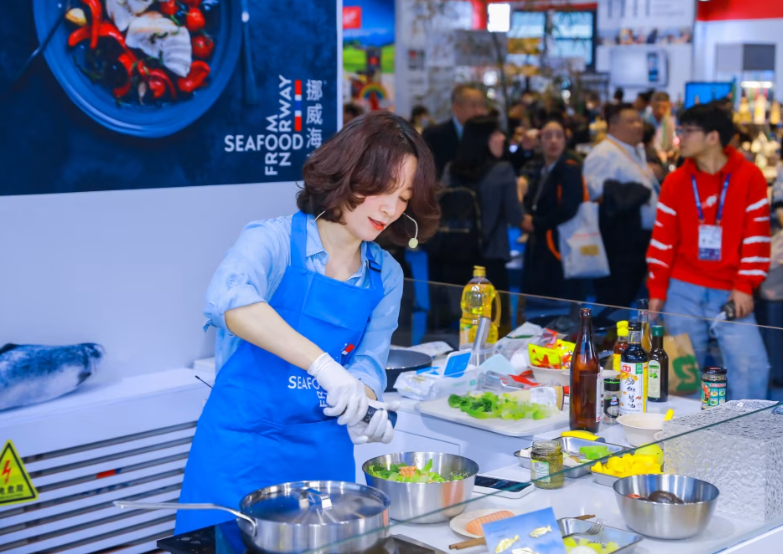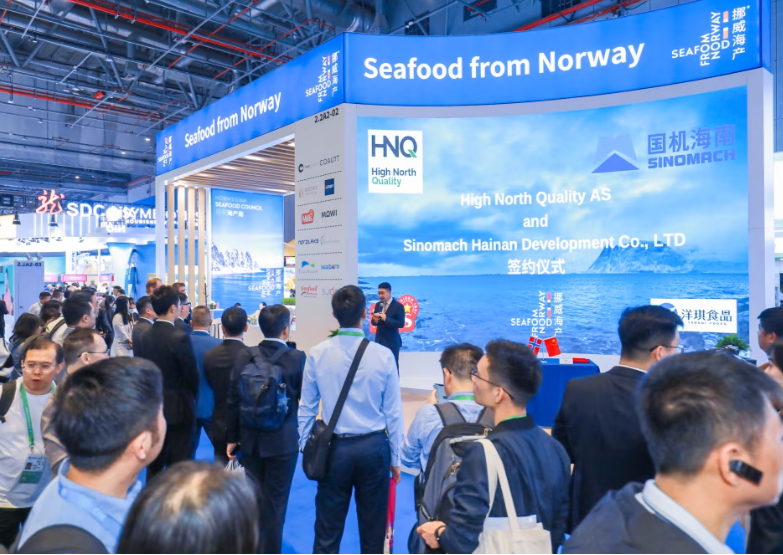|

Photo: Norwegian Seafood Council
'Particularly important for the Norwegian seafood industry to be visible in China'
 NORWAY
NORWAY
Monday, December 04, 2023, 02:00 (GMT + 9)
For the first time, China is the largest market in Asia when it comes to Norwegian salmon. Japan has been pushed down from the throne. So far this year, Norway has exported almost 60 percent more salmon to China than at the same time before the pandemic. - When such things happen, it is important to be on the ball. We must maintain our market shares and get the Chinese to associate Norwegian seafood with quality, safety and good taste.
The export value to China is in a positive trend - and with the help of good visibility, Norwegian seafood can become even more popular among the Chinese.
 Andreas Thorud, the Seafood Council's envoy in China, has together with many Norwegian exporters profiled Norwegian seafood at the major fairs China Fisheries & Seafood Expo in Qingdao and China International Import Expo (CIIE) in Shanghai. Andreas Thorud, the Seafood Council's envoy in China, has together with many Norwegian exporters profiled Norwegian seafood at the major fairs China Fisheries & Seafood Expo in Qingdao and China International Import Expo (CIIE) in Shanghai.
"China is an extremely exciting country at the moment, which is why we have been keen to showcase seafood of Norwegian origin at these large fairs", says Thorud.
The participation at CIIE in particular has given Norway good visibility.
"CIIE is a prestigious project for the Chinese authorities, and participants there receive a lot of attention. We have concentrated on showcasing our seafood products, with the message that this is healthy and proper food".
Thorud believes trade fair participation and PR exposure are important, especially because of China's focus on the health of its population, which is also part of the government's goals anchored in "Healthy China 2030". The latter will ensure that the Chinese population has access to good health, including through the right diet.
"We have been keen to show that Norwegian seafood can be a small part of the overall solution", Thorud explains.

Photo: Norwegian Seafood Council
Share knowledge about Norwegian seafood
By building their own Norwegian pavilions at these large fairs, as well as conducting seminars and knowledge meetings, both the Norwegian industry and the Seafood Council have been in contact with several hundred participants from the local Chinese value chain, stakeholders within the industry, the logistics sector, Chinese media and customers.
"It is important that we can tell the Chinese how we catch and manage our seafood in Norway, because we have great opportunities in this market. The middle class here is growing, so the demand for both white fish, pelagic and salmon will increase - also in the lesser-known cities in the country", says Thorud.
Norwegian authorship marking in shops
He says that for the first time China is the biggest market in Asia when it comes to Norwegian salmon. That is, Japan has been pushed down from the throne.
So far this year, Norway has exported almost 60 percent more salmon to China than at the same time before the pandemic.

Photo: Norwegian Seafood Council
"When such things happen, it is important to be on the ball. We must maintain our market shares and get the Chinese to associate Norwegian seafood with quality, safety and good taste", says Thorud.
He believes that participation in the two major trade fairs has contributed to precisely this.
"Visibility in such arenas is one of several tools, because we have to think long-term now that the Chinese market is developing. Norwegian seafood must be included now that Chinese consumers are creating new habits. We must have a preference in the market, and to achieve that we must constantly work towards the Chinese consumer".
Thorud is particularly pleased that several grocery chains have started with good origin labeling on Norwegian seafood.
"Norwegian seafood has an exciting time ahead of it in the Chinese market, and our job is to create greater preference and add value", concludes Thorud.
Source: Norwegian Seafood Council (Translated from original in norwegian)
[email protected]
www.seafood.media
|



